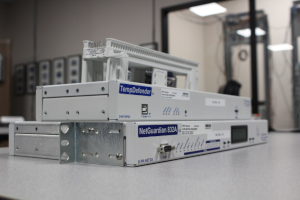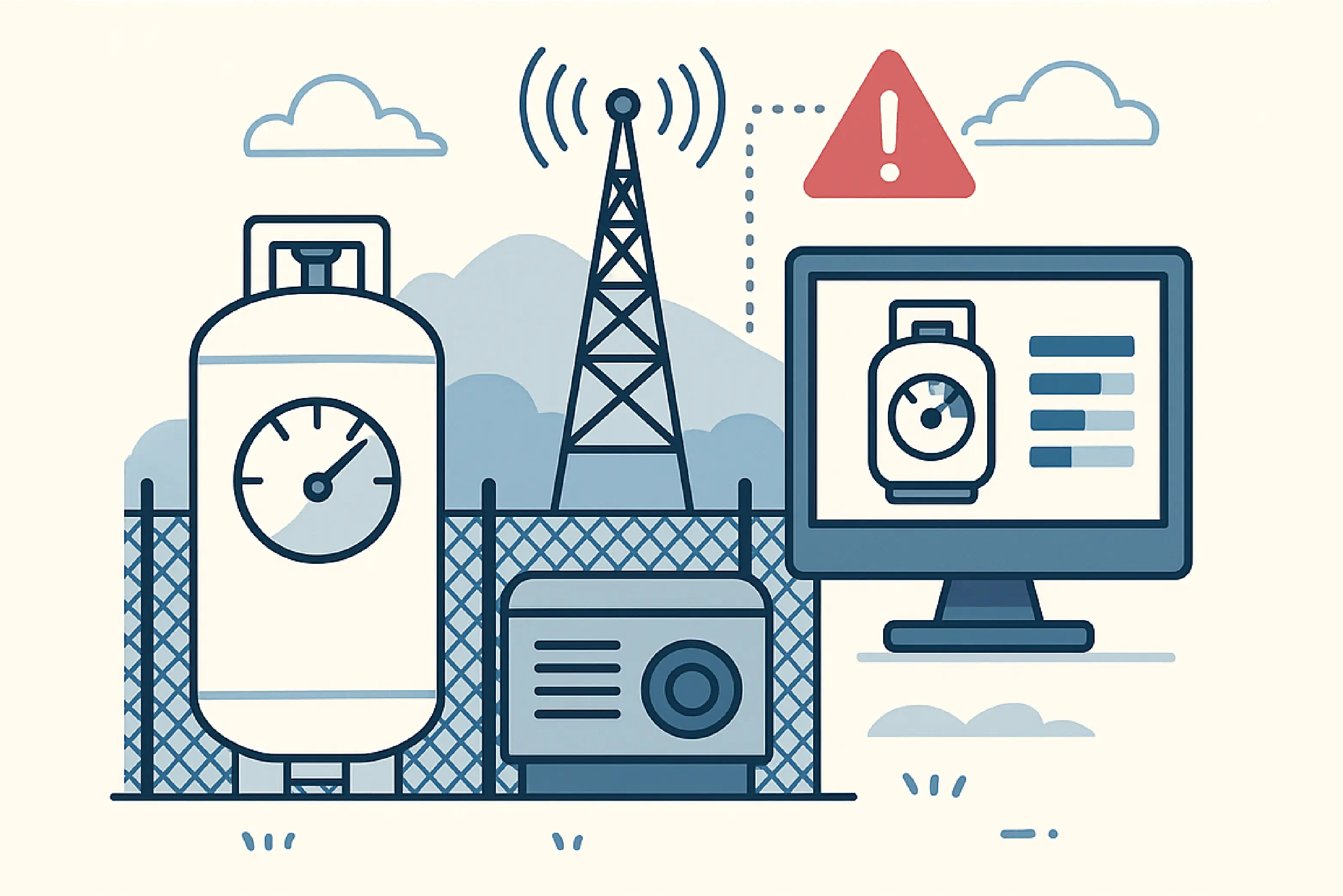Check out our White Paper Series!
A complete library of helpful advice and survival guides for every aspect of system monitoring and control.
1-800-693-0351
Have a specific question? Ask our team of expert engineers and get a specific answer!
Sign up for the next DPS Factory Training!

Whether you're new to our equipment or you've used it for years, DPS factory training is the best way to get more from your monitoring.
Reserve Your Seat TodayWhen you're managing a critical emergency communication system, backup power isn't optional. It's essentially your last line of defense.
Yet, even with good generators and large propane tanks in place, many counties and agencies across the U.S. are still operating blindly when it comes to fuel levels.
That's the exact situation one rural county found itself in recently. After investing $20 million into a state-of-the-art, multi-site radio system, they discovered a major blind spot that threatened the reliability of their entire infrastructure.
Their generators ran on propane, but nobody could see the tank levels remotely.
Let's walk through what this team encountered, how their original approach had no real chance of working, and how a better fuel monitoring strategy can eliminate guesswork, improve uptime, and finally give you peace of mind during outages.

This county's radio system consists of 12 tower sites, each with its own 1,000-gallon propane tank powering a backup generator. These sites are spread across a large, rural area right on the US-Canada border, making logistics and environmental access challenging.
Since generators are only used during power outages, the tanks deplete very slowly. In fact, the propane vendor actually preferred to wait until a tank hit 30% before refilling.
From the vendor's perspective, that makes sense. It maximizes efficiency by delivering fewer, larger fills. Although that does make them wait a bit longer for revenue, it does mean that they were selling more gallons per site visit.
But for the county's Emergency Management team, 30% simply wasn't acceptable when power losses could strike unexpectedly.
"In my world, Emergency Management and emergency communications, I want the tank filled," one of the officials explained.
In other words, "enough" isn't enough when lives are on the line. During an extended power outage, or in a winter storm, 30% capacity might not get you through the night.
Full tanks can and should give you confidence. Anything less introduces pointless risk.
The team needed a way to monitor tank levels without physically visiting each remote site, especially during storms or when roads were inaccessible.
In the absence of automation, the county did what many agencies still do: monthly site visits.
A county employee would drive to each tower site, open the tank enclosure, and manually record propane levels. These handwritten readings would then be collected and logged.
This outdated approach has several issues:
With 12 sites spread across a large rural area, site visits took hours (or even days), especially during harsh winter weather.
Human error is inevitable. Readings can be missed, misread, or skipped altogether if access is blocked or delayed.
Even with monthly checks, a lot can happen in 30 days. If a generator kicks on during a prolonged power outage, you won't know the fuel level has dropped significantly until it's too late.
As one county official pointed out, the radio team essentially consists of just two people. These two individuals are responsible for managing daily ops, supporting 800 employees, and now preparing to touch over 3,000 radios for a full system reprogramming. They simply don't have time to "babysit" propane tanks.
Imagine that you have a system where:
This is what's already happening with DPS Telecom gear in radio systems, utilities, transportation networks, and critical infrastructure across North America.
And you can do all of this without setting foot in the field.
These systems make the difference between being proactive and reactive. You don't have to wait for something to go wrong to take action.
At DPS Telecom, we've spent 30+ years helping organizations gain real-time visibility at their remote sites. Propane monitoring is just one of many sensor inputs we support, but it's one of the most important for generator uptime.
Our NetGuardian RTUs (Remote Telemetry Units) can monitor analog tank sensors, commonly 4-20mA or 0-5VDC, to read precise propane levels. These RTUs install at each site and report back to your central monitoring server.
Each RTU:
You'll have visibility into propane levels and other vital conditions like generator run status, site temperature, battery voltage, and door access - all from one device.
When you have multiple RTUs across your network, you need a central aggregator to collect and display all that information. That's where T/Mon comes in.
T/Mon is a central alarm master that:
Whether you're monitoring 5 sites or 500, T/Mon gives you the centralized control room you've been missing.
Many propane vendors now offer their own monitoring systems. Unfortunately, they tend to come with strings attached, including:
With DPS, you own the monitoring hardware and software. There's no monthly fee and no reliance on outside vendors. You decide how and where data is displayed, and we help you integrate with your existing systems.
Whether you're in southern California or New York or Hawaii or Alaska, environmental challenges differ.
In this case, the client operates with sites just a few miles from Canada. Cell towers can bounce signals across the border, triggering international roaming fees. That's why the county moved to another service provider, which supports cross-border coverage for public safety.
We've worked in these kinds of environments before, and we can design monitoring systems that don't lose contact, even in fringe coverage zones or during power outages.
This particular county didn't come to us just looking to monitor propane. While that was their initial concern, it was clear they needed broader visibility, as well.
As we continued talking, we learned:
In other words: they have no time for unreliable, wasteful processes.
That's why we showed them not only how our devices monitor propane levels, but also how DPS gear can scale to support other needs. These can include generator start/stop, power failure alerts, HVAC control, intrusion detection, and more.
We even discussed capturing email alerts and automatically integrating them into their monitoring dashboard, using simple scripting and mediation tools available in our gear.
We're not just selling devices. We're helping you design a full solution tailored to your environment.
Your infrastructure is too important to leave to chance.
If your team is still checking up on propane tanks by hand - or relying on fuel vendors to tell you when it's time to refill - you're putting your entire operation at risk.
DPS Telecom can help you:
You don't have to be a monitoring expert, we'll do that part for you.
Just tell us what you're working with today, and we'll build a proposal that fits your needs.
Call Us Today: (559) 454-1600
Email: sales@dpstele.com
You'll talk with a real engineer (not a sales rep) who understands your world.
We'll show you exactly how propane monitoring works, what sensors and RTUs are compatible with your tanks, and how to scale your system without wasting money.
Even if you're not ready to buy yet, we'll arm you with valuable information so you can plan effectively - and avoid costly mistakes.
Don't wait for a low tank alarm to surprise you. Let's make sure you see every fuel level - before it becomes a problem.

Andrew Erickson
Andrew Erickson is an Application Engineer at DPS Telecom, a manufacturer of semi-custom remote alarm monitoring systems based in Fresno, California. Andrew brings more than 18 years of experience building site monitoring solutions, developing intuitive user interfaces and documentation, and opt...